Latest Data-Centric News Highlights
In a significant stride towards smarter and more sustainable urban development, AI systems are proving to be invaluable tools in addressing urban heat islands and flood levels in urban planning.
Predictive analytics, generative AI, and digital twins are at the forefront of this revolution. Predictive analytics, by analysing large datasets such as weather patterns and infrastructure usage, can forecast impacts like heat intensification or flood risks. This empowers planners to design preventive measures or optimize resource allocation, such as cooling infrastructure or drainage systems [1].
Generative AI, on the other hand, can autonomously create multiple urban design alternatives. These models consider constraints like avoiding flood-prone zones and enhancing green spaces to mitigate heat islands. AI models iteratively refine planning proposals in collaboration with human planners based on real-time feedback [2][3]. For instance, AI can propose higher-density zoning plans that carefully preserve parks that provide urban cooling [2].
Digital twins, high-fidelity virtual replicas of urban environments, allow real-time simulation of spatial configurations and their effects on heat dynamics and floodwater flow. These simulations provide actionable insight into how different designs influence urban resilience and environmental sustainability, accelerating decision-making and allowing adaptive planning with continuous impact assessment [2][3][4].
Human-Machine Collaborative Planning enables urban planners to interactively engage with AI systems via conversational interfaces, providing contextual and normative constraints (e.g., policy priorities) to ensure that solutions balance technical, social, and ecological goals [2].
San Francisco officials have launched an urban heat mapping project, using volunteer-collected data on heat and humidity from sensors installed in cars on 12 city routes. Meanwhile, in New York City, officials, along with researchers from City University of New York and New York University, have launched a real-time flood level dashboard using citywide sensors [5].
In the realm of consumer applications, JCPenney has launched an AI-powered tool for online skincare and makeup shopping, personalizing recommendations based on customer pictures and self-reported data, and offering an augmented reality feature for makeup trials [6]. Google, on the other hand, has expanded its Maps tool to offer energy-efficient route suggestions in nearly 40 European countries, based on vehicle type and AI-generated data [7].
OpenAI's text-to-image AI system DALL-E now includes an Outpainting tool that extends existing paintings beyond their original borders, maintaining the original style [8].
As we move forward, the integration of AI in urban planning promises a future where cities can better manage urban heat islands and flood levels, paving the way for smarter, sustainable urban development.
[1] [Source] [2] [Source] [3] [Source] [4] [Source] [5] [Source] [6] [Source] [7] [Source] [8] [Source]
- The integration of artificial intelligence in urban planning is significantly aiding smarter and more sustainable urban development, notably in addressing urban heat islands and flood levels.
- Predictive analytics, a key component, analyzes large datasets to forecast impacts like heat intensification or flood risks, empowering planners to design preventive measures or optimize resource allocation.
- Generative AI, another crucial tool, can autonomously create multiple urban design alternatives, considering constraints like avoiding flood-prone zones and enhancing green spaces to mitigate heat islands.
- Digital twins, high-fidelity virtual replicas of urban environments, allow real-time simulation of spatial configurations and their effects on heat dynamics and floodwater flow, providing actionable insight for urban resilience and environmental sustainability.
- Human-Machine Collaborative Planning enables urban planners to interactively engage with AI systems, providing contextual and normative constraints to ensure solutions balance technical, social, and ecological goals.
- In the consumer sector, AI is being used for personalized recommendations in skincare and makeup shopping, while Google Maps now offers energy-efficient route suggestions based on AI-generated data.
- OpenAI's text-to-image AI system DALL-E includes an Outpainting tool that extends existing paintings beyond their original borders, maintaining the original style.
- As we advance, the future holds a promise where cities can better manage urban heat islands and flood levels, paving the way for smarter, sustainable urban development, potentially impacting areas like health-and-wellness, climate-change, finance, business, environmental-science, space-and-astronomy, and data-and-cloud-computing.




